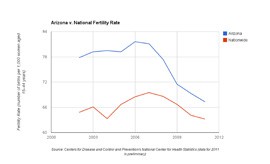Cronkite News has moved to a new home at cronkitenews.azpbs.org. Use this site to search archives from 2011 to May 2015. You can search the new site for current stories.
Arizona continues trend of fewer babies, in part because of bad economy
PHOENIX – Arizona women had fewer babies in 2011 for the fifth straight year, due in large part to tighter wallets, social changes, lower teen pregnancy rates and departures among the Hispanic population.
Fertility rates have historically tended to fall amid recessions, as incomes shrink or fears of job loss pressure couples to put off having children.
“A typical recession is fairly brief,” said Tom Rex, associate director of the Center for Competitiveness and Prosperity Research at Arizona State University’s W.P. Carey School of Business. “This recession was much longer, so we’ve seen a much longer decline.”
The latest estimates from the Centers for Disease and Control and Prevention’s National Center for Health Statistics showed that Arizona’s fertility rate, defined as the number of newborns per 1,000 women ages 15 to 44, was 67.3 during 2011, down from 69.3 the previous year.
Nationwide, that figure fell from 64.1 in 2010 to 63.2 last year, its lowest level ever, according to the CDC’s preliminary data. Arizona had the 14th-highest fertility rate among the states.
In addition to a severe downturn in the economy, Rex said that state laws targeting illegal immigrants drove many Hispanics out of the state, further lowering the rate of births.
Arizona Hispanics have a fertility rate almost twice that of white non-Hispanics, according to DATOS: Tucson, a report released in September by the Arizona Hispanic Chamber of Commerce and Tucson Hispanic Chamber of Commerce.
Sheila Sjolander, assistant director of the Division of Public Health Prevention at the Arizona Department of Health Services, said that a drop in teen pregnancies has also contributed to the decline.
“Young women and men are being more planful about their pregnancies. In public health that’s a good thing,” Sjolander said.
With more funding and programs aimed at teen pregnancy prevention than ever, Sjolander said the state is now seeing the benefits of these efforts.
Ronald Gunderson, professor of economics at Northern Arizona University’s W.A. Franke College of Business, said that lifestyle changes among couples are also factoring into a more permanent decline.
“Right now I think we’re starting to fall into the European path,” Gunderson said. “There are periods of time when couples just decide that they don’t want children.”
Fewer kids translates to less strain on the public education system as well as a potential change in the composition of the housing stock and retail market, Gunderson said. It will also contribute to demographic aging, meaning fewer people paying into Social Security and a growing number collecting it.
“But that’s going to happen anyway when the baby boomers retire,” he added.
Jim Chang, state demographer for the Office of Employment & Population Statistics at the Arizona Department of Administration, said that fertility rates have stabilized since the start of 2012.
“It’s maybe a reflection of recovery … better economic times to come,” Chang said. “We’ve probably stopped losing population.”
Rex said he suspects that once the 2012 data comes in there will be an uptick in the fertility rate.
“I don’t see that much impact though on the economy even if there is some long-term downward trend,” he said.







